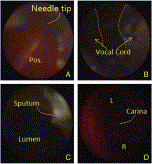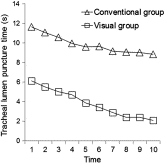A new strategy for difficult airway management with visual needle cricothyroidotomy: a manikin study☆☆☆
Affiliations
- Department of Respiratory Medicine, The First Affiliated Hospital of Chongqing Medical University, Chongqing 400016, P.R. China
Affiliations
- Department of Geriatrics, The First Affiliated Hospital of Chongqing Medical University, Chongqing 400016, P.R. China
Affiliations
- Department of Geriatrics, The First Affiliated Hospital of Chongqing Medical University, Chongqing 400016, P.R. China
Affiliations
- Department of Geriatrics, The First Affiliated Hospital of Chongqing Medical University, Chongqing 400016, P.R. China
Affiliations
- Department of Geriatrics, The First Affiliated Hospital of Chongqing Medical University, Chongqing 400016, P.R. China
Affiliations
- Department of Geriatrics, The First Affiliated Hospital of Chongqing Medical University, Chongqing 400016, P.R. China
Affiliations
- Department of Geriatrics, The First Affiliated Hospital of Chongqing Medical University, Chongqing 400016, P.R. China
Affiliations
- Department of Geriatrics, The First Affiliated Hospital of Chongqing Medical University, Chongqing 400016, P.R. China
Affiliations
- Department of Ultrasound, The First Affiliated Hospital of Chongqing Medical University, Chongqing 400016, P.R. China
Affiliations
- Department of Critical Care Medicine, The First Affiliated Hospital of Chongqing Medical University, Chongqing 400016, P.R. China
Correspondence
- Corresponding author. Department of Critical Care Medicine, The First Affiliated Hospital of Chongqing Medical University, Chongqing 400016, P.R. China, No. 1 Youyi Road, Yuzhong District, Chongqing 400016, P.R. China. Tel.: +86 139 83207360; fax: +86 023 68811487.

Affiliations
- Department of Critical Care Medicine, The First Affiliated Hospital of Chongqing Medical University, Chongqing 400016, P.R. China
Correspondence
- Corresponding author. Department of Critical Care Medicine, The First Affiliated Hospital of Chongqing Medical University, Chongqing 400016, P.R. China, No. 1 Youyi Road, Yuzhong District, Chongqing 400016, P.R. China. Tel.: +86 139 83207360; fax: +86 023 68811487.
 Article Info
Article Info
To view the full text, please login as a subscribed user or purchase a subscription. Click here to view the full text on ScienceDirect.

Fig. 1
A, The prototype of the visually guided needle cricothyroidotomy system, consisting of a monitor, light source port, imaging source port, video capture box, notebook computer, microimaging fiber, and 14G needle. B, At the distal end, there was a microimaging fiber (a), 14G needle (b), “Y” connector (c), and three-way switch (d).

Fig. 2
A, The tracheal structure acquired in the visual group, showing the needle tip, posterior tracheal wall (pos.), and bronchus ring. The airway structure was simultaneously acquired by further delivering the microimaging fiber beyond the needle tip. B, The structure of the upper airway, including the pharynx and vocal cord. C, Sputum attached to the tracheal wall. D, The structure of the lower airway, including the carina, left bronchus (L), and right bronchus (R). The whole procedure is easier to interpret in the full motion video clip, which is demonstrated in video 1 in the supplemental data.

Fig. 3
Comparison of tracheal lumen puncture times between the conventional and visual groups.
Highlights
- •
A 0.9-mm microimaging fiber was delivered into a 14G needle to develop a visual puncture system.
- •
This study used this visual puncture system to perform needle cricothyroidotomy.
- •
To the best of our knowledge, this is the first experience to investigate the feasibility and efficiency of this video-assisted system for needle cricothyroidotomy in manikin.
- •
Under visual guidance, the needle tip of this visual puncture system was delivered into the tracheal lumen with proper position. In comparison to the conventional group, due to visual guidance, this new strategy had less procedure time and procedure-related complications.
- •
Moreover, the anatomy of both the upper and lower airways was acquired, which could provide useful information for diagnostic purposes. Therefore, visually guided needle cricothyroidotomy may be a new strategy for difficult airway management in future care.
Abstract
Background
Conventional needle cricothyroidotomy uses blind manipulation. We investigated the feasibility and efficiency of a new visually guided needle cricothyroidotomy technique.
Methods
A 0.9-mm microimaging fiber was delivered into a 14G needle to develop a visual puncture system. 10 inexperienced physicians were randomly assigned to perform 10 repeated needle cricothyroidotomy in each group with both conventional method and visual puncture in a manikin. Tracheal lumen puncture time and number of procedure-related complications were recorded.
Results
Under visual guidance, the needle successfully reached the tracheal lumen. The anatomy of the upper and lower airways was acquired by further advancing the microimaging fiber into the tracheal lumen of the visual group. The tracheal lumen puncture time was significantly less in the visual group than in the conventional group (3.85 ± 1.54 vs. 9.84 ± 1.08 seconds, P < .001). Damage to the posterior tracheal wall was not observed in the visual group; however, 21% of manikins in the conventional group had procedure-related complications.
Conclusions
Our results demonstrate that visual needle cricothyroidotomy is feasible, and may lead to a decrease in procedure time and procedure-related complications compared to the conventional procedure. In addition, this strategy may also provide useful information for diagnostic purposes; therefore, visual needle cricothyroidotomy may be a new strategy for the management of difficult airways in future care.
To access this article, please choose from the options below
Purchase access to this article
Claim Access
If you are a current subscriber with Society Membership or an Account Number, claim your access now.
Subscribe to this title
Purchase a subscription to gain access to this and all other articles in this journal.
Institutional Access
Visit ScienceDirect to see if you have access via your institution.
☆This study was performed at Chongqing Medical University.
☆☆Funding support: The present study is supported by the National Natural Science Foundation of China (81201173), the Chongqing Science and Technology Commission (CSTC, 2009ab5218) and Chongqing Municipal Health Bureau project (2009–2317).
Related Articles
Searching for related articles..



